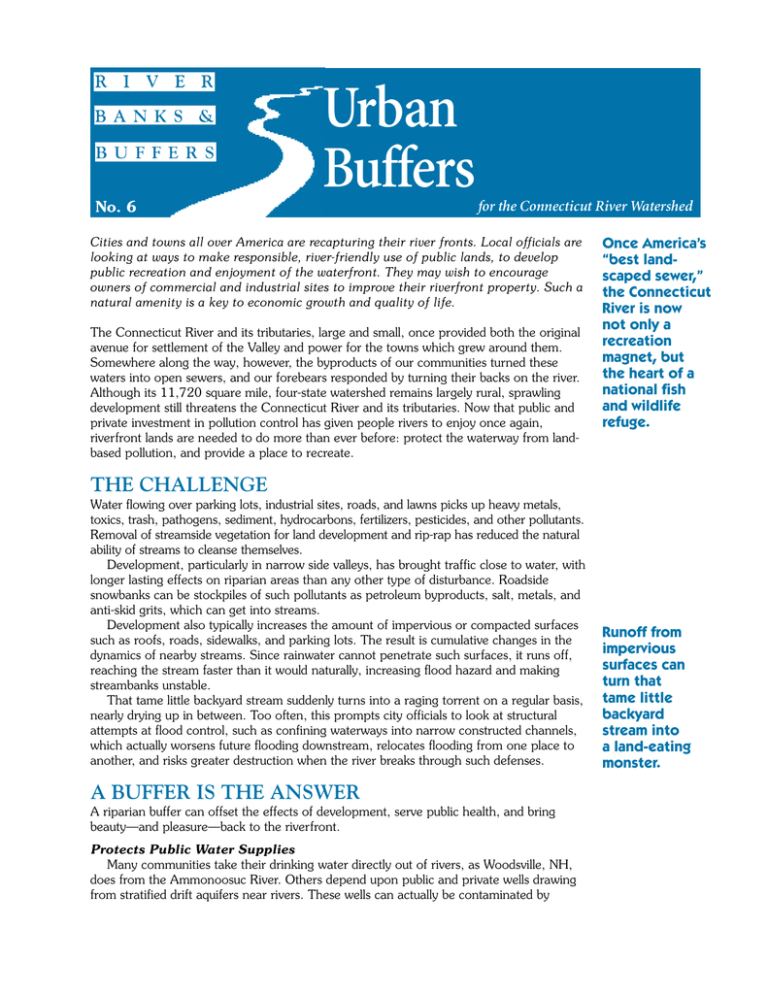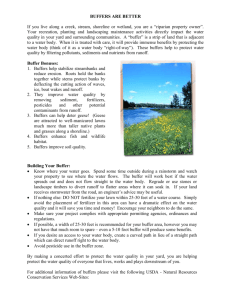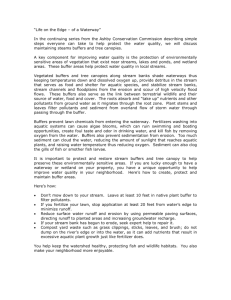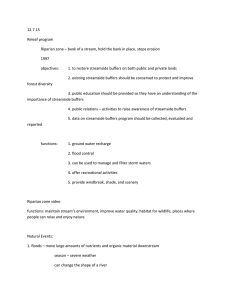Urban Buffers - Connecticut River Joint Commissions
advertisement

No. 6 Urban Buffers for the Connecticut River Watershed Cities and towns all over America are recapturing their river fronts. Local officials are looking at ways to make responsible, river-friendly use of public lands, to develop public recreation and enjoyment of the waterfront. They may wish to encourage owners of commercial and industrial sites to improve their riverfront property. Such a natural amenity is a key to economic growth and quality of life. The Connecticut River and its tributaries, large and small, once provided both the original avenue for settlement of the Valley and power for the towns which grew around them. Somewhere along the way, however, the byproducts of our communities turned these waters into open sewers, and our forebears responded by turning their backs on the river. Although its 11,720 square mile, four-state watershed remains largely rural, sprawling development still threatens the Connecticut River and its tributaries. Now that public and private investment in pollution control has given people rivers to enjoy once again, riverfront lands are needed to do more than ever before: protect the waterway from landbased pollution, and provide a place to recreate. Once America’s “best landscaped sewer,” the Connecticut River is now not only a recreation magnet, but the heart of a national fish and wildlife refuge. THE CHALLENGE Water flowing over parking lots, industrial sites, roads, and lawns picks up heavy metals, toxics, trash, pathogens, sediment, hydrocarbons, fertilizers, pesticides, and other pollutants. Removal of streamside vegetation for land development and rip-rap has reduced the natural ability of streams to cleanse themselves. Development, particularly in narrow side valleys, has brought traffic close to water, with longer lasting effects on riparian areas than any other type of disturbance. Roadside snowbanks can be stockpiles of such pollutants as petroleum byproducts, salt, metals, and anti-skid grits, which can get into streams. Development also typically increases the amount of impervious or compacted surfaces such as roofs, roads, sidewalks, and parking lots. The result is cumulative changes in the dynamics of nearby streams. Since rainwater cannot penetrate such surfaces, it runs off, reaching the stream faster than it would naturally, increasing flood hazard and making streambanks unstable. That tame little backyard stream suddenly turns into a raging torrent on a regular basis, nearly drying up in between. Too often, this prompts city officials to look at structural attempts at flood control, such as confining waterways into narrow constructed channels, which actually worsens future flooding downstream, relocates flooding from one place to another, and risks greater destruction when the river breaks through such defenses. A BUFFER IS THE ANSWER A riparian buffer can offset the effects of development, serve public health, and bring beauty—and pleasure—back to the riverfront. Protects Public Water Supplies Many communities take their drinking water directly out of rivers, as Woodsville, NH, does from the Ammonoosuc River. Others depend upon public and private wells drawing from stratified drift aquifers near rivers. These wells can actually be contaminated by Runoff from impervious surfaces can turn that tame little backyard stream into a land-eating monster. pollutants from parking lots, lawns, or agricultural chemicals in rivers 1000 feet away. Nature has provided a very efficient, low-cost and low-maintenance water treatment system in the form of natural riparian vegetation. Keeping streamside land naturally vegetated is a far more effective and less expensive way to safeguard drinking water over the long term than building elaborate facilities to treat polluted water. Forests are especially good at both cleansing runoff and stowing this water in aquifers. Clearing a forest for development reduces by 33-67% the water infiltrating the soil to become groundwater than if the forest, with its root network and more porous soils, had been left in place. Protects Property Streamside land is a high risk area for development even above flood elevation. Public and private investments in property risk damage or loss if stream dynamics are ignored. Using vegetated buffers to set back human developments and land uses from shorelines is cost effective protection against the hazards caused by flooding, shoreline erosion and moving streams. Sheet No. 7 in this series offers guidance for town officials and developers on various ways to promote buffers. Provides Community Value Disguised as riverfront parks, riparian buffers can host a range of activities with economic and educational value to the community. Welcome the public to hike or bike, walk or run on trails, or try their luck in fishing tournaments. Excursion boats, water parades, canoeing or kayaking races, and rowing regattas can launch on larger rivers. Riverside festivals and concerts have a special appeal. Forested buffers are good locations for ropes adventure courses, orienteering competitions, or marathons. Public gardens offer pleasant passive recreation. People will notice that a forested buffer/park is especially enjoyable because it reduces noise from nearby roads, development and industry, and offers a cool, shaded place for a picnic with a view. In winter, the riparian buffer offers space for snowshoeing, cross-country skiing, and ice skating. Riparian forests in heavily developed areas may be the refuge of last resort for a variety of birds and other animals, and offer the best birdwatching in town. A buffer is a good place for river-related school studies and adult workshops in natural history. By making riparian buffers people-friendly places, smart communities gather allies for river protection and encourage citizen participation. Citizen groups can develop a feeling of ownership that translates into monitoring, volunteer labor, and a welcome source of stewardship for town property. Corporate citizens owning riverfront property can contribute to the quality of life for their employees and the community at large. Disguise riparian buffers as riverside parks. Supports Stream Life The quality of life in a stream goes distinctly downhill when its watershed reaches 10-15% of impervious cover. Above 25% impervious cover, it can no longer support aquatic life. Heavy metals, common in runoff from urbanized areas, accumulate in fish tissues, threatening fish health as well as those who eat them. However, streams flowing through urbanized areas with intact streamside forests have healthier aquatic life than those that do not. Microbes in forest soil can convert some pollutants into less toxic forms. Protects Historic and Archeological Resources To the Valley’s native people, rivers provided food and served as transportation arteries and geographic markers. The remains of villages, hunting and fishing camps, and seasonal activity sites are commonly discovered near the water’s edge. The Connecticut River’s tributaries later provided access into the interiors of Vermont and New Hampshire for 18th century Euro-Americans. Vegetated, stable streambanks help to preserve archeological and historic sites from erosion and other disturbance. GETTING STARTED Urban situations confront planners, property owners, and city officials with more space and zoning constraints than in more rural areas. Check local zoning and master plan provisions for shoreline setbacks. Perform a visual analysis of existing buffers to see where to focus municipal effort, and perhaps financial incentives, to restore missing buffers. Nature illustrations: David M. Carroll Limit encroachments through site planning by setting back permanent structures, roads, and paved paths as far as possible, where streamside vegetation exists or could be restored. Avoid creating new bridge, sewer, or utility crossings except where there is no reasonable alternative. Check culverts to ensure that they can handle a 100-year storm and offer fish passage. Arch, or other “bottomless” culverts allow the best fish movement. For an Unstable Riverbank Deal with an eroding riverbank first before restoring its buffer. Urban riverbanks often show evidence of past abuse and will benefit from the advice of a trained specialist. Consult The Challenge of Erosion in the Connecticut River Watershed, published by the Connecticut River Joint Commissions. Structural solutions, such as rip-rap and retaining walls, are as hard on the river and buffer as they are on the eye. Use them only on the lower portion of the vertical profile to the extent necessary, and only when bio-engineering techniques may not be adequate to prevent significant losses of land and property. Where Natural Vegetation Exists Discourage the cutting of existing trees and other vegetation on stream banks. Plans to cut selected trees near the bank or shoreline for views and recreational access should ensure that a canopy is maintained. Maintain the duff layer to the greatest extent possible, and leave stumps with their roots intact to help hold the bank in place. Convert runoff to sheet flow by regrading or using landscape timbers, stone, or other structural devices. Where Natural Vegetation Has Been Removed Revegetate streamsides as well as rock rip-rapped areas with native shrubs, trees and grasses on as much of the vertical profile as possible. To avoid raising water temperature live stakes can be driven into joints of rip-rap where they will sprout, shrouding and shading the stone. Vines can also help here. Where native streamside vegetation is gone but soil remains, change mowing and cutting practices to allow gradual natural succession of native plants. Better yet, plant groups of attractive native shrubs and trees to hasten buffer restoration. Since the urban buffer forms the boundary between the natural and man-made worlds, the most successful planting design aims for an unmanicured look. Check the plant list in this series for native plants with ornamental value or those that attract birds, butterflies, or other desirable wildlife. Set them in irregular groups of odd numbers of plants for a naturalistic effect. Where riparian land has been paved, communities such as Hartford, CT, are reversing this all too common riverbank treatment by relocating roads, removing pavement, and restoring vegetation. DEALING WITH URBAN STORMWATER Riparian buffers can do only part of the job when there’s a man-made stormwater transport system in the picture. An urban buffer’s ability to treat stormwater depends on how much the flow has become channelized before it enters, and how long it is detained in the buffer. If a buffer receives stormwater directly from impervious areas, use flow-spreading devices such as multiple curb cuts or spacers to distribute flow. Buffers are useful wherever runoff heads toward a river, such as around storm drains, detention ponds, and drainage ditches. Where a river front has already been developed and vegetated buffers cannot be restored, turn to structural technology, such as detention ponds, infiltration systems, and commercially available stormwater treatment systems. These may be required if the watershed has a high percentage of impervious surface, since its stream may produce more sediment-laden runoff than a buffer can effectively handle. Note that some urban pollutants pass through a buffer unchanged: salt, heavy metals such as cobalt, lead, and mercury are not removed by natural buffer processes. The choice to place a stormwater detention pond within a buffer depends upon the relative impacts and performance potential. Ponds can contribute to stream warming, but can also lend habitat diversity to the buffer. Limit such ponds to the outer or middle zones, and avoid placing them where they could threaten bank stability or where groundwater lies close to the surface—the pond could recharge the aquifer with dissolved pollutants. A buffer is a river’s right-of-way. Rip-rap usually results in buffer destruction and can trigger new erosion. Showcase native Connecticut River Valley plants. PLAN FOR RECREATIONAL USE Guide river access by establishing well defined trails and paths to help keep the streambank stable. Use marker posts, boulders, signs, and fences to direct traffic by people and equipment. Design trails to run across rather than down slope, to avoid creating runoff problems and erosion. A common mistake is to run a bike path right next to a river, which can result in an open swath rather than a closed tree canopy. Instead, locate bike paths at a slight distance, with spurs to the river. Designate sensitive areas, especially steep slopes, for low impact use rather than high impact activities such as off road vehicles, biking, or horseback riding. Restrict access where vegetation is not fully established or is of a rare type. If problems arise, discuss trail closures, tree cutting, or other decisions with interested citizen groups in advance. In high use areas, select structurally reinforced turf systems rather than an impervious surface. Encourage pet owners to avoid walking their dogs in areas where pet droppings could wash off into the stream, and remind them to pick up after their pets. To protect public safety, plant low, deciduous shrubs or ground covers and prune tree branches to 8' above the ground along walkways. Provide carefully selected illumination to avoid over-lighting the landscape. MANAGING A RIPARIAN BUFFER Inspect the buffer regularly and remove accumulated sediments in the outer grass zone. Exclude dumping, filling, and construction machinery from the buffer to protect damage to soils and vegetation. Caution road crews to avoid mowing riparian buffers where roadways abut waterways. Mowing of the outer grass buffer, however, is important for vigorous sod growth and helps remove the nutrients and pollutants it has captured. Raking leaves, clearing brush, and removing fallen logs can significantly reduce the time that runoff is detained and cleaned by the buffer. If the public demands it, restrict such tidying up to highly visible areas, and screen the view of the rest with ferns and low growing shrubs. Reduce water and maintenance needs by mulching with shredded bark, leaf mulch or bark chips. Cedar and redwood bark are not recommended because their chemistry interferes with buffer function. While fresh wood chips are often available from highway crews, they should be composted for six months to avoid introducing disease and other troubles. Use only lime or wood ash to fertilize near a stream, and avoid pesticides. Cut only trees that threaten to pull the riverbank with them if they fall, but leave their root systems in place to hold the bank. Remove a tree snag from a stream channel only when it clearly presents a flood hazard. Identify and control invasive exotic plants—they can quickly spread and overrun less aggressive native plants. Educate the public about the value and function of the buffer through signage, meetings with homeowner associations, and field demonstrations, to help prevent encroachment. KNOW STATE AND LOCAL REGULATIONS Since riparian buffers are among the best ways to protect the quality of rivers and streams, state and many local authorities have taken steps to protect them. In both Vermont and New Hampshire, septic systems must be set back 75' from rivers and streams, and most municipalities have setbacks for structures. Some require buffers of a standard width, and others prescribe a range and assign a width appropriate to the site. In New Hampshire, the Comprehensive Shoreland Protection Act (RSA 483-B) protects existing natural woodland buffers within 150' of the public boundary line on all 4th order streams, including lower portions of the Ashuelot, Ammonoosuc, Cold, Gale, Israel, Mascoma, Mohawk, Sugar, Little Sugar, and Upper Ammonoosuc rivers, and Mink, Partridge, and Stocker brooks. On these waterways not more than 50% of the basal area of trees and a maximum of 50% of the total number of saplings can be removed in a 20-year period. A healthy, well-distributed stand of trees, saplings, shrubs, and ground covers and their living, undamaged root systems shall be left in place. While the Connecticut River mainstem was exempt from this law at the time of printing, the law may apply in the future. In Vermont, the Agency of Natural Resources has adopted a Buffer Procedure pursuant to 3 V.S.A. § 835 which is not a rule or regulation, but may be used as guidance in conditioning permits. Prevent encroachment through public education. ANATOMY OF A BUFFER Use the description below as a general guide which can be altered to fit the available space between the river and the built environment. While it is never in the best long-term interest of either the public or the landowner to sacrifice an existing riparian buffer for development next to a river or stream, even a 50' buffer is better than no buffer at all. For more on buffer width, see Introduction to Riparian Buffers, No. 1 in this series. Three Zone Buffer System The most effective urban buffers have three zones. ❧ streamside: to top of bank for erosion control, shade, visual screen, noise control ❧ middle zone: inland from top of bank; to capture pollutants and recharge groundwater; width should ideally reflect size of stream, extent of 100 year flood plain, and adjacent steep slopes; the goal is a mature woodland, with some clearing for recreational uses ❧ outer zone: between the rest of the buffer and the nearest permanent structure; to capture sediment and absorb runoff; open, unpaved space (turf or lawn); playing fields, gardens, playgrounds, and other common community activities are suitable Riparian Buffer athletic fields gardens lawns picnic areas playgrounds trails bike paths Grass and herbaceous plants spread surface runoff to catch sediment and improve infiltration and water storage trails bike paths shade gardens picnic tables benches demonstration plantings arboretum Woodland provides habitat and purifies surface and subsurface water trail spurs to lookouts benches controlled access to water arboretum Undisturbed shrubs and trees provide habitat, shade water and stabilize bank THE BETTER BUFFER Naturally vegetated streamside forests are the best possible use of land when it comes to water quality, land and water recreation, and wildlife habitat. While available open space near waterways is often limited in heavily developed areas, encourage the widest possible forested buffer wherever space permits. The longer runoff is detained in the buffer before entering the stream, the better. Plant labeled demonstration gardens of native tree, shrub, and herbaceous species for public education and enjoyment, such as a garden of plants valuable to wildlife. Add buffers (disguised perhaps as shrub borders, or flower beds surrounded by filtering grass) between paved areas and storm drains or ditches. WHAT ABOUT COSTS? It’s hard to put a dollar figure on the value of watching migrating songbirds or the quality of life provided by a public waterfront park. The following list describes some of the costs and benefits involved in adding a buffer in an urban setting. Costs Bgrass or wildflower seed Bcorrection of compacted soil or other soil problems Bplant material: use cuttings or bare root plants from a native source; nursery grown plants are more expensive but more reliable Bmulch, if not provided by highway crews and composted in advance Blabor in planting, pruning, mowing, sediment removal Bsignage and fencing to guide public use if appropriate Bmonitoring for signs of erosion and plant damage Bcost of administering buffer program Bland acquisition (if applicable) Benefits Breduced costs for mowing and maintaining open fields Breduced costs for fertilizer, pesticides, herbicides, fuel, equipment maintenance Bavoided costs of engineering design, permits, and bank stabilization Bpublic land: recreation area and activities within buffer and along waterfront Bcleaner, safer, more attractive water for recreation Bsafer, more reliable drinking water from public water supplies Baverted costs of building drinking water treatment system Bflood protection Bimproved ambient air temperature and quality in summer Bvisual screen and noise buffer between land and water Bpreserve important habitat Bbetter fishing Bincreased property values Further Reading A Guide to Developing and Re-Developing Shoreland Property in New Hampshire, North Country Resource Conservation & Development Area. 1999 Stormwater Management and Erosion and Sediment Control Handbook for Urban and Developing Areas in NH. 1992 BMPs for Erosion Control During Trail Maintenance and Construction, NH Department of Resources & Economic Development. 1994 Fact sheets in the series Riparian Buffers for the Connecticut River Watershed No. 1 Introduction to Riparian Buffers No. 2 Backyard Buffers No. 3 Forestland Buffers No. 4 Buffers for Habitat No. 5 Buffers for Agricultural Land No. 6 Urban Buffers No. 7 Guidance for Communities No. 8 Planting Riparian Buffers (& plant list) No. 9 Field Assessment No. 10 Sources of Assistance See also the companion series for land owners: The Challenge of Erosion in the Connecticut River Valley, Connecticut River Joint Commissions, 1998. Part of the Living with the River series. May be reprinted without permission. Riparian Buffers for the Connecticut River Watershed was prepared by the Connecticut River Joint Commissions of NH & VT with support from the Silvio O. Conte National Fish & Wildlife Refuge Challenge Cost Share Program, PG&E National Energy Group, NH Dept. of Environmental Services, and EPA. Technical assistance was provided by UNH Cooperative Extension Service, USDA Natural Resources Conservation Service, VT Dept. of Environmental Conservation, Connecticut River Conservation District Coalition, Upper Valley Land Trust, Environmental Protection Agency, Appalachian Mountain Club, NH Dept. of Environmental Services, US Fish & Wildlife Service, PG&E National Energy Group, CRJC river commissioners and local river subcommittee members. September 2000 PO Box 1182 • Charlestown NH 03603 • 603-826-4800 • WWW.CRJC.ORG






